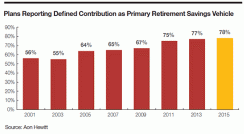To view a PDF of the full report, click here.
By Richard Westlund
When planning for retirement, American workers face a host of challenges: saving for the future, making good investment choices and turning those assets into a comfortable stream of income. While many large public and private employers still offer traditional defined benefit (DB) pension plans, more employees must rely on defined contribution (DC) plans such as 401(k)s, for their financial health in retirement.

“There has been a steady shift from DB to DC plans,” says Rob Austin, director of retirement research, Aon Hewitt. “Our latest research shows that 78 percent of companies rely on their DC plan to be the primary retirement vehicle, while 22 percent still have traditional DB plans that meet their workforce needs.”
But Katie Taylor, director of thought leadership, Fidelity Investments, points out that many DC plan sponsors still regard their plans as supplements. “That mindset needs to change,” she says.
Fortunately, DC plan sponsors are looking at refining their strategies to improve outcomes for their participants, including automated enrollment, larger employer matches and target date funds (TDFs) that allocate assets based on years to retirement and other factors.
“Automated enrollment and escalation are becoming much more common in the DC marketplace,” says Sean McShea, president of Ryan Labs Asset Management, a Sun Life Investment Management company. “After all, many DC plans don’t have a consultant and an actuary to explain to young people that their contributions will be critical to enjoying a comfortable retirement.”
Meanwhile, DB plans face a different set of challenges in striving to maintain adequate funding levels to meet their long-term pension liabilities. “For pension plans, the top priorities are controlling for risk and volatility,” says Austin.
McShea suggests that DB plan sponsors create a custom liability benchmark. “You need to understand the cash flows necessary to fund those liabilities and have realistic market return expectations.”
Focusing on retirement income
One of the major shifts in DC plans has been a growing focus on retirement income. “If workplace plans are not set up to help employees replace their paychecks once they retire, then you should look at taking action and changing the plan features,” says Taylor. A Fidelity survey in mid 2015 showed nearly 20 percent of DC plan sponsors had income replacement as a goal, compared with 4 percent in 2013. “There is still a long way to go, but more and more sponsors are understanding the importance of setting a goal for their plans,” she says.
Online tools that allow participants to see their projected retirement income, including comparisons with their peers, can help increase contribution rates,” says Edmund Murphy III, president of Empower Retirement. “When participants log into their accounts, they don’t know whether a balance of $50,000 or $100,000 is good or bad. You have to provide a context, so they where they stand on the track for retirement.”
But replacement income is only half of the financial equation for retirement, adds Murphy. “We need to take a holistic approach and look at liabilities as well,” he says. “Most participants don’t realize that up to one-third of their retirement income may be needed for healthcare costs, and that doesn’t include long-term care.”
A recent Empower paper, “An Apple a Day: The Impact of Health Conditions on the Required Savings for Healthcare,” covered the cost considerations for retirees. For example, a healthy 65-year-old male retiree would need $144,000 and a female would need $156,000 for Medicare parts B and D, supplemental insurance and out-of-pocket expenses. “Understanding those costs can be an impetus for participants to increase their savings rates to the recommended 10 percent level rather than the average 6 to 7 percent,” Murphy added.
DC plan designs
In the DC world, sponsors have taken a wide approach to plan design, says Ruthann Pritchard, institutional portfolio manager, target-date strategies, Fidelity Investments. “It is fascinating to see the diversity of plan designs, which reflect the composition of the participant base,” she says. For instance, an employer with a high turnover of younger workers might take a different approach to a DC plan than a professional firm with older, long-tenure employees.
Aon Hewitt’s 2015 survey, “Trends & Experience in Defined Contribution Plans,” found that DC plans are changing in rapid ways as employers seek to promote more participation, encourage greater savings, and improve investment funds. Among the highlights:
- 52 percent of employers auto-enrolled workers at a savings rate of 4 percent or more
- The most popular employer match rate was $1 for $1, and 42 percent of employers had this formula
- 57 percent of plans required workers to save 6 percent or more in order to receive the full employer matching contribution
- 58 percent of plans offered Roth IRA contributions
- 17 percent of plans used customized TDFs
- 60 percent of plans had online guidance
- 55 percent had managed accounts
- 53 percent had online advice
- 80 percent of employers used personalized communication
Taylor advises DC plan sponsors to provide participants with educational components. “Communications are far more successful when they are targeted to a specific audience such as pre-retirees,” she says. “The more you personalize messaging to specific employees, the greater the likelihood that the employee will engage and take action.”
Noting the greater role that TDFs are playing in DC plans, Pritchard says, “Sponsors need to understand what the provider is trying to achieve and how that strategy will be implemented to ensure it meets the plan’s goals.”
Withdrawal strategies
With 10,000 Boomers turning 65 every day, withdrawal strategies are increasingly important for DC plan sponsors. “Participants want to know how much they can drive down their accounts in the most tax-efficient manner,” says Murphy. “Social Security claiming strategies are another concern as employees near retirement.”
Murphy says some plan sponsors are offering a face-to-face engagement model for pre-retirees, along with clear online guidance. “Industry jargon and difficulties in navigating online sites have made it difficult for participants to make decisions,” he adds. “We believe in the importance of offering a user experience that allows participants to see the financial impact of their decisions.”
While many DC plan sponsors have looked at annuities, there has not been a large pick-up, according to Austin. “Instead, DC plans are allowing participants to withdraw their money over time rather than taking out the balance upon retirement,” he says. “In many cases a DC plan has better-performing investments and lower fees then an IRA or other individual vehicles.
Portability is another big issue, especially for younger workers who may change jobs every few years. “Fortunately many plans are now allowing roll-ins to the new plan to take advantage of institutional pricing and other benefits,” says Murphy.
Looking ahead
With retirement readiness a growing national concern, federal regulators are looking at how to help the 50 million workers at smaller businesses who currently lack access to a DC plan. As Murphy says, “We need to expand the DC universe and address that challenge.”





